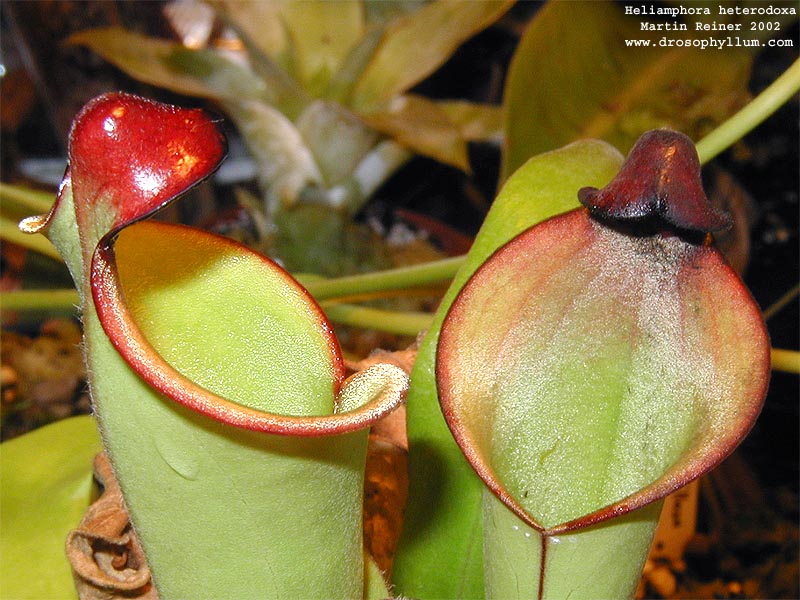
 |
|
|||||||
| Heliamphora Everything about Sun Pitchers |
 |
|
|
Thread Tools | Search this Thread | Display Modes |
|
|
|
#1
|
|||
|
|||
|
Visitors to the recent Penang Flora Fest were aware that there were 7 pots of heliamphoras for sale. They were gone in a flash.
Just who got the 7th plant. Well thanks to David I got one of the plants for sale. The moment David saw the plants, he telephoned me. He told me they were big. Boy compared to the other helias I have, they are giant. Okay, so what is the ID of the plant. That should not be very hard. Unlike nepenthes and droseras, there are only about 15 known heliamphoras around. The most commonly sold (or rather the cheapest) species ar N. minor and H. nutans. It also happened that I bought Stewart McPherson book, "Pither Plants of the Americas". From the book, I can see that the plants that were sold have the shape of H. nutans. But in the description of the species, Stewart did warn that: "The overwhelming majority of the H. nutans plants grown in cultivation are actually either hybrids with H. glabra or artificial crossbreed produced by horticulturists." A cross-check on H. glabra description, Stewart, had this to say: "The nectar spoon lid is helmet shaped and has a distinctive knob-like bulge at its apex which is consistently present. This feature is also reliably inherited in H glabra x nutans hybrids." So, owners of these plants take note. The plants you are having are H glabra x nutans hybrid. Happy growing. Choong |
|
#2
|
|||
|
|||
|
Oooo, you are great Choong, thanks for sharing the info. We always hope to have more people like you.

|
|
#3
|
|||
|
|||
|
Hi Choong,
I had taken few days to compared the internet information and book. I feel it more to H. heterodoxa x nutans which is common selling at online nursery. And there is no sign of H glabra x nutans hybrid. H. glabra  H.heterodoxa 
|
|
#4
|
||||
|
||||
|
The shape of Heliamphora pitchers differs quite a lot in different light conditions. By looking at the spoon and pitcher shape alone, it is not definite that the species can be identified.
Look at the example given here: http://home.arcor.de/j.danz/H_nutans_f.html
__________________
Never argue with idiots. They bring you down to their level, then beat you with experience! |
|
#5
|
|||
|
|||
|
Actually I am obverse major on the spoon lid and others of the pitcher.
H. glabra is new specie as before that it name as H.heterodoxa var glaba. (Information from internet) Maybe Choong is right it could be H.glaba x nutans hybrid. And could be market commonly mark it H.heterodoxa x nutans hybrid. Anyway, this is discussion to find out the 7th plant ID. |
|
#6
|
|||
|
|||
|
Hi Eric,
Thanks for your input. What Stewart is trying to say is that when we buy H. nutans, we invariably get H. glabra x nutans hybrid. This is a natural occurring hybrid. And when they cross back with the parents they are hard to distinguish. It is like buying N. alata and ending up with N x Venrata! I have studied a few photos of heterodoxa, nutans and heterodoxa x nutans (http://www.humboldt.edu/~rrz7001/Heliamphora.html). If you look at heterodoxa x nutans hybrid you will see that the wing occur very high up, close to the opening (http://www.fotop.net/averyorchids/He...nutans?r=fotop) whereas, nutans and glabra x nutans wings appear close to the ventricose. In fact, if you compare our plants with photos of H. nutans, you will think they are H. nutans. One typical H. nutans photo (http://www.bestcarnivorousplants.org...sr72-1281.html). Then again this could be a hybrid too! Choong |
|
#7
|
|||
|
|||
|
Hmm... very interesting discussion. Guess we need to wait till plant be mature to identify again. This is my Heliamphora picture.

|
|
#8
|
|||
|
|||
|
If I had more time I would have tried the plant.
Last edited by TS; 17th January 2011 at 11:27 AM. |
|
#9
|
|||
|
|||
|
can we see the nectar spoon of these plants ?
on the picture these heliamphora have some problem of light , normaly the nectar spoon must be red if they are in good condition. for the heterodoxa you have 2 species , from ptari tepui and from the gran sabana , the pitcher form are not the same and the nectar spoon also. these heliamphora ( on the picture) come from nursery , but what are their tracability ? the glabra specie is rare in cultivate , nutans , heterodoxa , minor very common . see here my updated web site for this genus Heliamphora jeff Last edited by jeff; 30th January 2011 at 07:56 PM. |
 |
| Currently Active Users Viewing This Thread: 1 (0 members and 1 guests) | |
| Thread Tools | Search this Thread |
| Display Modes | |
|
|